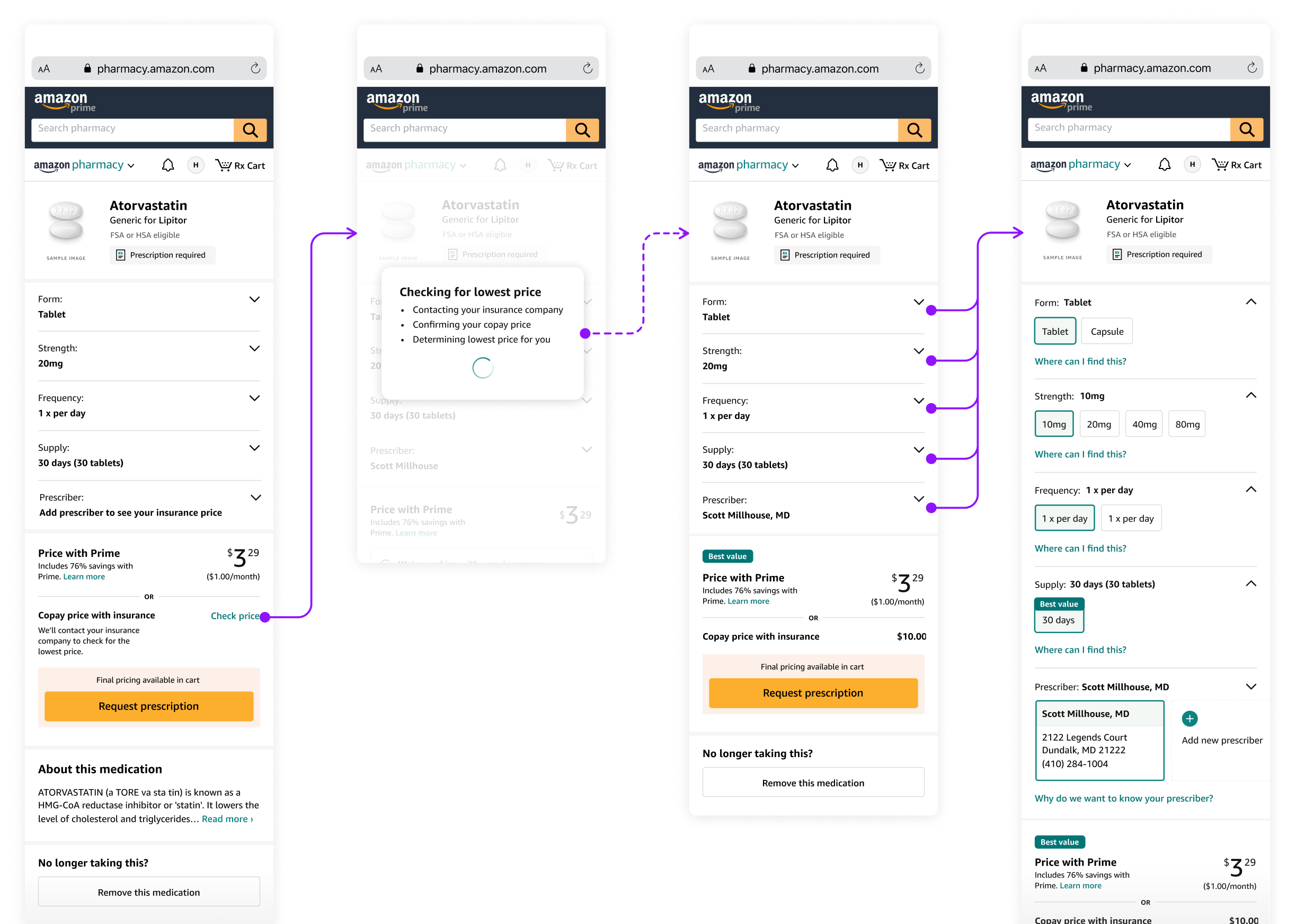Summary
Customers should have the best possible pricing and insurance coverage information to commit to sign-up for Amazon Pharmacy (AP), make an informed prescription chase decision, and make a fully informed purchase decision before cart, especially given our desire to drive competition (e.g., 3P vs 1P, coupons, Prime Rx etc.) on featured offers - enabling pharmacy to be "shoppable" like any retail category. Customer feedback post the general availability (GA) launch of AP has highlighted pricing visibility as a key customer expectation and point of friction with the current experience. 50% of post-GA feedback has been related to pricing and, from the latest customer feedback survey, 40% of customers didn't initiate a chase after signing up because they wanted to understand pricing. To address this complexity, give customers choice and transparency while simplifying decision making, and face out prices which are meaningful to the majority of customers, we will enable an insurance pricing experience in 2021.
Tenets
With all of my projects, I track key decisions that I revisit for all presentations, in order to make sure all stakeholders are aligned or if they have alternative suggestions or debate that needs to be had. For Insurance Pricing, the tenets we arrived at were:
- Lean into lowest prices: We will default to form/strength with the lowest price. For Prime customers this should be the lowest Prime Rx unit price, for NPA or cases where the Prime price isnt present this should be the lowest U&C unit price.
- Bias for prices, not perfection: We are proposing to build on what we launched for GA + test/provisional claims. We’ll layer on a payer API, once available.
- Make it scalable for future feature launches: We have 2 related projects (Flex supply, EDS) that this project should build toward.
- Simplify where possible: We removed form, strength, and prescriber from the chase flow, in lieu of corresponding twisters on the MIP.
Iteration
Given that there wasn't really anything like it in the market, I utilized existing Amazon frameworks and best practices around the "buy box" to provide the clearest messaging. I always try to aim for as many concepts as possible, give them unique mnemonics to keep them straight, and provide pros and cons to objectively narrow to the best options (see below). This recommended idea then is floated around to management and leadership to continue vetting it's viability. In this case, option 3 was agreed upon and we continued forward.
Lorem ipsum dolar sit amet. Lorem ipsum dolar sit amet. Lorem ipsum dolar sit amet.
Lorem ipsum dolar sit amet. Lorem ipsum dolar sit amet. Lorem ipsum dolar sit amet.
Reaching out to insurance
When customers change their strength, form, etc. from the twisters, we needed a way to pause the UI in order to make a call to the customer's insurance company for the updated pricing (only 1 price could be called at a time and we needed to restrict colliding requests). Talking with our dev team, we determined it would take approximately 4-6 seconds. I took a look at several options that assumed the ability to have real-time qualitative updates so the customer underrstands why we need to block their experience for that duration.
Lorem ipsum dolar sit amet. Lorem ipsum dolar sit amet. Lorem ipsum dolar sit amet.
Unfortunately, we found out that we could not provide the granular system updates for our V1. Considering the amount of time between steps as being too short for meaningful understanding, I decided this wasn't a deal breaker for the customer. Instead, I looked a spin on the winning concept above, but tried to make it static while still communicating the value of the need to block their experience. I also worked with our Principal UX Writer to craft the best messaging.
Lorem ipsum dolar sit amet. Lorem ipsum dolar sit amet. Lorem ipsum dolar sit amet.
Technical scope change requires customer to manually trigger the insurance lookup
I had worked with our product owner to ensure that we would be able to do insurance pricing updates asynchronously with insurance companies. However, we were notified that due to resource constraints that we wouldn't be able to achieve by our launch date. So, I needed to jump back into the design to understand how we could include or new or utilize an existing call-to-action.
Lorem ipsum dolar sit amet. Lorem ipsum dolar sit amet. Lorem ipsum dolar sit amet.
Launched nationwide
Through multiple pivots and constraint tech capability, we were able to launch on-time. We saw call volume to Customer Care decrease, conversion to request prescriptions increase by 20%, and overall NPS went up. This work also unlocked subsequent launches of 90-day supply, which was a strategic advantage for Amazon Pharmacy in order to be competitive with other Mail Order companies as well as cover the capabilities that Pillpack already maintained.
Lorem ipsum dolar sit amet. Lorem ipsum dolar sit amet. Lorem ipsum dolar sit amet.
Lorem ipsum dolar sit amet. Lorem ipsum dolar sit amet. Lorem ipsum dolar sit amet.
Lorem ipsum dolar sit amet. Lorem ipsum dolar sit amet. Lorem ipsum dolar sit amet.









